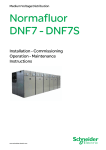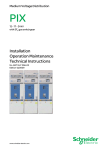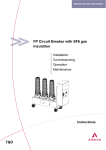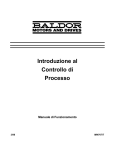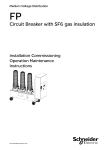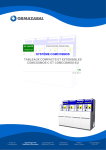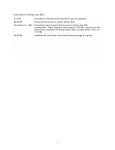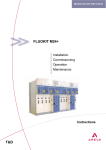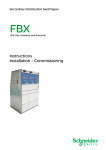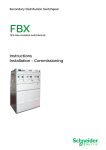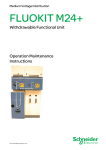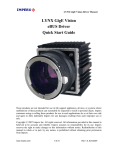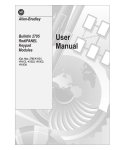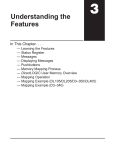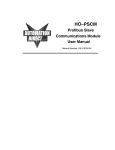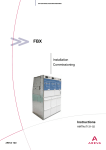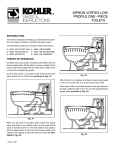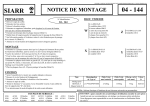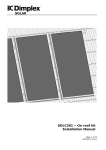Download NoT013-02 SE
Transcript
Primary Distribution Switchgear DNF7 - DNF7S Normafluor Instructions Installation - Commissioning - Operation - Maintenance DNF7 - DNF7S Contents 1 Schneider Electric at your service . . . . . . . . . . . . . . . . . . . 1 1.1 1.2 1.3 1.4 1.5 Particular instructions for operations and interventions . . . . . . . . . . . . . . . . . . . Protection equipments . . . . . . . . . . . . . . . . . . . . . . . . . . . . . . . . . . . . . . . . . . . . . . Symbols of information . . . . . . . . . . . . . . . . . . . . . . . . . . . . . . . . . . . . . . . . . . . . . Symbols and important safety informations . . . . . . . . . . . . . . . . . . . . . . . . . . . . Contacts . . . . . . . . . . . . . . . . . . . . . . . . . . . . . . . . . . . . . . . . . . . . . . . . . . . . . . . . . 1 1 1 1 1 2 With regards to this User Manual . . . . . . . . . . . . . . . . . . . . 2 2.1 2.2 Eco-design concept and valorization of the materials used . . . . . . . . . . . . . . . Reminder concerning normal service conditions (in accordance with IEC62271-1) . . . . . . . . . . . . . . . . . . . . . . . . . . . . . . . . . . . . . . . . . . . . . . . . . . * Permissible ambient temperature . . . . . . . . . . . . . . . . . . . . . . . . . . . . . . . . . . . * Installation altitude . . . . . . . . . . . . . . . . . . . . . . . . . . . . . . . . . . . . . . . . . . . . . . . . * Atmospheric pollution . . . . . . . . . . . . . . . . . . . . . . . . . . . . . . . . . . . . . . . . . . . . . * Permissible atmospheric humidity level . . . . . . . . . . . . . . . . . . . . . . . . . . . . . . Other technical notices to be consulted . . . . . . . . . . . . . . . . . . . . . . . . . . . . . . . . Tightening torque values [Nm] for standard assemblies (nut + bolt) . . . . . . . . . Tools and products (not supplied) required for the operations described in this notice . . . . . . . . . . . . . . . . . . . . . . . . . . . . . . . . . . . . . . . . . . . . . . . . . . . . . . . . . . . . 2 2 2 2 2 2 2 2 3 Presentation . . . . . . . . . . . . . . . . . . . . . . . . . . . . . . . . . . . . . . . 4 3.1 3.2 4 3.5 3.6 Description . . . . . . . . . . . . . . . . . . . . . . . . . . . . . . . . . . . . . . . . . . . . . . . . . . . . . . . Dimensions and weights of the functional units equipped with a circuit-breaker [with packaging] . . . . . . . . . . . . . . . . . . . . . . . . . . . . . . . . . . . . . . . . . . . . . . . . . . . Dimensions and weights of the functional units with no circuit breaker [with packaging] . . . . . . . . . . . . . . . . . . . . . . . . . . . . . . . . . . . . . . . . . . . . . . . . . . . Dimensions and weights of the circuit breaker moving parts delivered separately [with packaging] . . . . . . . . . . . . . . . . . . . . . . . . . . . . . . . . . . . . . . . . . . . . . . . . . . . Presentation of the functional units . . . . . . . . . . . . . . . . . . . . . . . . . . . . . . . . . . . ”Bus-riser” functional unit . . . . . . . . . . . . . . . . . . . . . . . . . . . . . . . . . . . . . . . . . . . 4 Packaging - Handling - Storage . . . . . . . . . . . . . . . . . . . . . . 4.1 4.2 4.3 4.4 4.5 4.6 4.7 4.8 4.9 Packaging . . . . . . . . . . . . . . . . . . . . . . . . . . . . . . . . . . . . . . . . . . . . . . . . . . . . . . . . Reception . . . . . . . . . . . . . . . . . . . . . . . . . . . . . . . . . . . . . . . . . . . . . . . . . . . . . . . . Handling of the functional unit . . . . . . . . . . . . . . . . . . . . . . . . . . . . . . . . . . . . . . . . Unpacking and handling of the high voltage moving part, delivered separately Storage conditions . . . . . . . . . . . . . . . . . . . . . . . . . . . . . . . . . . . . . . . . . . . . . . . . . Intervention levels . . . . . . . . . . . . . . . . . . . . . . . . . . . . . . . . . . . . . . . . . . . . . . . . . Specific recommendations for storage durations of less than 6 months . . . . . Specific recommendations for storage durations of between 6 and 12 months Specific recommendations for storage durations of between 12 and 24 months . . . . . . . . . . . . . . . . . . . . . . . . . . . . . . . . . . . . . . . . . . . . . . . . . . . . 7 7 8 8 9 9 10 10 5 Unpacking and assembling the equipment . . . . . . . . . . . 11 5.1 5.2 5.3 5.4 5.5 Civil engineering characteristics . . . . . . . . . . . . . . . . . . . . . . . . . . . . . . . . . . . . . . Unpacking of the functional units . . . . . . . . . . . . . . . . . . . . . . . . . . . . . . . . . . . . . Handling of the functional unit (without a circuit breaker) . . . . . . . . . . . . . . . . . Identification of the functional units and circuit breakers . . . . . . . . . . . . . . . . . . Installation on the floor . . . . . . . . . . . . . . . . . . . . . . . . . . . . . . . . . . . . . . . . . . . . . 11 11 12 12 13 6 Installation - Connections . . . . . . . . . . . . . . . . . . . . . . . . . . . 14 6.1 6.2 6.3 6.4 6.5 6.6 6.7 6.8 6.9 6.10 6.11 6.12 Presentation of the functional units . . . . . . . . . . . . . . . . . . . . . . . . . . . . . . . . . . . Installation of each functional unit . . . . . . . . . . . . . . . . . . . . . . . . . . . . . . . . . . . . Standard case of attachment to the floor . . . . . . . . . . . . . . . . . . . . . . . . . . . . . . . Inter-functional unit earthing circuit connection . . . . . . . . . . . . . . . . . . . . . . . . . . Earthing circuit connection, at the far end of the switchboard . . . . . . . . . . . . . . Installation of the voltage transformer housing ”busbars” . . . . . . . . . . . . . . . . . Connecting the earthing circuit of the busbar voltage transformer housing . . . Connecting the busbar . . . . . . . . . . . . . . . . . . . . . . . . . . . . . . . . . . . . . . . . . . . . . Preparation of the cable connection . . . . . . . . . . . . . . . . . . . . . . . . . . . . . . . . . . . Connecting the cables . . . . . . . . . . . . . . . . . . . . . . . . . . . . . . . . . . . . . . . . . . . . . . Inspections prior to commissioning . . . . . . . . . . . . . . . . . . . . . . . . . . . . . . . . . . . Summary of the main list of checks prior to commissioning . . . . . . . . . . . . . . . 14 14 14 15 15 16 16 17 19 20 21 21 2.3 2.4 2.5 3.3 3.4 AMTNoT013-02 revision: 04 3 4 4 4 5 6 7 10 i DNF7 - DNF7S ii 7 Operation . . . . . . . . . . . . . . . . . . . . . . . . . . . . . . . . . . . . . . . . . . 22 7.1 7.2 7.3 7.4 7.5 7.6 7.7 7.8 7.9 Operating levers . . . . . . . . . . . . . . . . . . . . . . . . . . . . . . . . . . . . . . . . . . . . . . . . . . . Opening operation of the earthing switch . . . . . . . . . . . . . . . . . . . . . . . . . . . . . . Closing operation of the earthing switch . . . . . . . . . . . . . . . . . . . . . . . . . . . . . . . Plugging-in and unplugging operations of the circuit breaker . . . . . . . . . . . . . . Unplugging operation of the circuit breaker up to the ”test” position . . . . . . . . . Complete unplugging operation of the circuit breaker . . . . . . . . . . . . . . . . . . . . Plugging-in operation of the circuit breaker . . . . . . . . . . . . . . . . . . . . . . . . . . . . . Mechanical device preventing any plugging-in operation . . . . . . . . . . . . . . . . . Operatings for the voltage transformer compartment . . . . . . . . . . . . . . . . . . . . . 22 22 23 24 24 25 25 26 27 8 Standard locking out and interlocking procedures . . . . 28 8.1 8.2 8.3 28 28 8.4 8.5 8.6 Functional mechanical interlocks . . . . . . . . . . . . . . . . . . . . . . . . . . . . . . . . . . . . . Immobilization device of the earthing switch by means of ”locks” . . . . . . . . . . Immobilization device for the earthing switch by means of ”padlocks” (not supplied) . . . . . . . . . . . . . . . . . . . . . . . . . . . . . . . . . . . . . . . . . . . . . . . . . . . . . Immobilization device for the plugging-in operation of the moving part . . . . . . Padlocking of the blanking shutters, by padlock (not supplied) . . . . . . . . . . . . Additional locking out and interlocking procedures . . . . . . . . . . . . . . . . . . . . . . 28 29 29 29 9 Commissioning . . . . . . . . . . . . . . . . . . . . . . . . . . . . . . . . . . . . 30 9.1 9.2 9.3 9.4 9.5 9.6 Reminder . . . . . . . . . . . . . . . . . . . . . . . . . . . . . . . . . . . . . . . . . . . . . . . . . . . . . . . . Inventory of tools and accessories on completion of work . . . . . . . . . . . . . . . . Pre-commissioning information . . . . . . . . . . . . . . . . . . . . . . . . . . . . . . . . . . . . . . Final checks before commissioning . . . . . . . . . . . . . . . . . . . . . . . . . . . . . . . . . . . Energizing the ”incoming” feeder functional unit . . . . . . . . . . . . . . . . . . . . . . . . . Checking the phase balance . . . . . . . . . . . . . . . . . . . . . . . . . . . . . . . . . . . . . . . . 30 30 30 30 31 31 10 Maintenance . . . . . . . . . . . . . . . . . . . . . . . . . . . . . . . . . . . . . . . 32 10.1 10.2 10.3 10.4 10.5 10.6 10.7 10.8 10.9 Levels of maintenance . . . . . . . . . . . . . . . . . . . . . . . . . . . . . . . . . . . . . . . . . . . . . Preventive maintenance for the circuit breaker moving part . . . . . . . . . . . . . . . Preventive maintenance of the functional units . . . . . . . . . . . . . . . . . . . . . . . . . Systematic maintenance . . . . . . . . . . . . . . . . . . . . . . . . . . . . . . . . . . . . . . . . . . . . Lubrication points in the moving par compartment . . . . . . . . . . . . . . . . . . . . . . . Lubrication points in the High voltage cable compartment . . . . . . . . . . . . . . . . Corrective maintenance of the functional units . . . . . . . . . . . . . . . . . . . . . . . . . . Replacement of a voltage transformer fuse . . . . . . . . . . . . . . . . . . . . . . . . . . . . Replacement of an internal element (insulator, capacitive divider, etc.) . . . . . . In the ”High Voltage cables” compartment . . . . . . . . . . . . . . . . . . . . . . . . . . . . . In the ”busbar” compartment . . . . . . . . . . . . . . . . . . . . . . . . . . . . . . . . . . . . . . . . 32 32 32 33 34 34 35 35 35 35 35 11 Spare parts . . . . . . . . . . . . . . . . . . . . . . . . . . . . . . . . . . . . . . . . 36 11.1 11.2 11.3 11.4 The spare part . . . . . . . . . . . . . . . . . . . . . . . . . . . . . . . . . . . . . . . . . . . . . . . . . . . . Identification of the equipment (see § 5.4) . . . . . . . . . . . . . . . . . . . . . . . . . . . . . . Storage conditions . . . . . . . . . . . . . . . . . . . . . . . . . . . . . . . . . . . . . . . . . . . . . . . . . Maintenance Consumables . . . . . . . . . . . . . . . . . . . . . . . . . . . . . . . . . . . . . . . . . 36 36 36 36 12 End of the equipment service life . . . . . . . . . . . . . . . . . . . . 37 12.1 12.2 12.3 Valorization of the equipment . . . . . . . . . . . . . . . . . . . . . . . . . . . . . . . . . . . . . . . . Safety instructions . . . . . . . . . . . . . . . . . . . . . . . . . . . . . . . . . . . . . . . . . . . . . . . . . Dismantling of the equipment . . . . . . . . . . . . . . . . . . . . . . . . . . . . . . . . . . . . . . . . 37 37 37 13 Notes . . . . . . . . . . . . . . . . . . . . . . . . . . . . . . . . . . . . . . . . . . . . . . 38 AMTNoT013-02 revision: 04 DNF7 - DNF7S 1 Schneider Electric at your service © - Schneider Electric - 2011. Schneider Electric, the Schneider Electric logo and their figurative forms are Schneider Electric registered trademarks. The other brand names mentioned within this document, whether they be copyright or not, belong to their respective holders. Schneider Electric request the carefully reading of the following instructions in order to familiarize yourself with the product in this document before trying to install, operation, put into service or conduct the maintenance on it. Our products are fully quality controlled and tested at the factory in accordance with the standards and regulations currently in force. The correct functioning and lifespan of the product depend on respecting the installation, commissioning and exploitation instructions found in this manual. Not respecting these instructions is likely to invalidate any guarantee. Local safety requirements which are in accordance with these instructions, especially those regarding the safety of product operators and other site workers, must be observed. Schneider Electric declines any responsibility for the following points: - the non respect of the recommendations in this manual which make reference to the international regulations in force. - the non respect of the instructions by the suppliers of cables and connection accessories during installation and fitting operations, - possible aggressive climatic conditions (humidity, pollution, etc.) acting in the immediate environment of the materials that are neither suitably adapted nor protected for these effects. 1.1 Particular instructions for operations and interventions This user manual does not list the locking-out procedures that must be applied. The interventions described are carried out on de-energized equipment (in the course of being installed) or locked out (non operational). 1.2 1.3 A qualified person is one who has the skills and knowledge related to the construction, installation and operation of electrical equipment and has received safety training to recognize and avoid the hazards involved. Except when it is imposed, the wearing of the gloves has been voluntarily limited in this manual so as to have clear visuals of the hands and operations described. Symbols of information 06 Code for a product recommended and marketed by Schneider Electric 21 Nm Tightening torque value Example: 21 Nm 10 Mark corresponding to a key Symbols and important safety informations The following special messages may appear throughout this bulletin or on the equipment to warn of potential hazards or to call attention to information that clarifies or simplifies a procedure. DANGER DANGER indicates an imminently hazardous situation which, if not avoided, will result in death or serious injury. 1.5 All operations must be completed once started. The durations (for completing the operations mentioned) given in the maintenance tables are purely an indication and depend on on-site conditions. Protection equipments Only qualified and accredited people can operate on our products. They must be equipped with all the correct protective equipment required for the task being performed. 1.4 Whilst commissioning and operating the product all general safety instructions for electrical applications (protective gloves, insulating stool, etc.) must be respected, this in addition to the standard operating instructions. WARNING WARNING indicates a potentially hazardous situation which, if not avoided, can result in death or serious injury. NOTICE NOTICE is used to address practices not related to physical injury. The safety alert symbol shall not be used with this signal word. CAUTION CAUTION indicates a potentially hazardous situation which, if not avoided, can result in minor or moderate injury. Contacts Group Schneider Electric service centers are there for: J J J J J J Engineering and technical assistance Commissioning Training Preventive and corrective maintenance Spare parts Adaptation work Schneider Electric Energy France 35 rue Joseph Monier - CS 30323 F-92506 Rueil-Malmaison Cedex www.schneider-electric.com AMTNoT013-02 revision: 04 1 DNF7 - DNF7S 2.1 2 With regards to this User Manual Eco-design concept and valorization of the materials used The design and manufacture of our packaging are both in conformity with the French government decree N° 98-638 of 20 July 1998, concerning the account that is taken of environmental requirements. 2.2 Reminder concerning normal service conditions (in accordance with IEC62271-1) * Permissible ambient temperature The ambient air temperature should be comprised between - 5°C and +40°C. The mean measured value for a 24 hour period must not exceed 35°C. * Installation altitude HV equipment are defined in accordance with European Standards and can be used up to an altitude of 1,000 m. Beyond this, account must be taken of the decrease in dielectric withstand. For these specific cases, contact the Schneider Electric Sales Department. * Atmospheric pollution The ambient air must not contain any dust particles, fumes or smoke, corrosive or flammable gases, vapours or salts. * Permissible atmospheric humidity level The average atmospheric relative humidity level measured over a 24-hour period must not exceed 95%. The average water vapour pressure over a period of 24 hours must not exceed 22 mbar. The average atmospheric relative humidity value measured over a period of one month must not exceed 90 %. The average water vapour pressure over a period of one month must not exceed 18 mbar. 2.3 J J J 2 corrective measures. For any assistance or advice, contact the Schneider Electric After-Sales Department. Whenever the humidity level is higher than 75%, we recommend that you take appropriate corrective measures for which Schneider Electric can offer you the necessary assistance. Please do not hesitate to contact us. Other technical notices to be consulted AMTNoT023 AMTNoT017 AMTNoT055 2.4 Condensation may appear in case of any sharp variation in temperature, due to excessive ventilation, a high atmospheric humidity level or the presence of hot air. This condensation can be avoided by an appropriate lay-out of the room or of the building (suitably adapted ventilation, air driers, heating etc.). Whenever the humidity level is higher than 95 %, we recommend that you take appropriate General lubrification instruction BLR(M) Control Mechanism ORTHOFLUOR FP Circuit Breaker Operation - Maintenance Installation - Commissioning - Operation - Maintenance Tightening torque values [Nm] for standard assemblies (nut + bolt) Threaded fasteners with grease Diameter Plastic (PA 6.6) Steel Class < 8.8 Steel Class > 8.8 < 10.9 M6 0.8 4.3 8.8 6.6 M8 1.8 10.5 21.0 15.8 M 10 3.5 14.0 42.0 35.0 M 12 6.0 - 70.0 60.0 M 16 12.0 - 170.0 134.0 A2-70 AMTNoT013-02 revision: 04 DNF7 - DNF7S 2.5 Tools and products (not supplied) required for the operations described in this notice ÎÎÎ - Cutter - Crow bar - Open-ended spanners size 13; 16; 18 - Socket wrenches size 8; 13; 16; 17; 18 - A/F Allen key size 6; 8; 10 - Torque wrench with sockets size 13; 16 and hexagon socket screw size 6; 8; 10 - Flat blade screwdriver - Rapid tightening pliers - 4 slings (1000 kg capacity) Product code - Clean dry cloth − - Solvent (dielectric withstand > 30 kV) excluding chlorinated solvents − - Mechanical grease : Mobilplex 47, Mobilux EP3 by Mobil or Stabilube T6 by Sophos - Molykote PG 54 grease for electrical contacts by Dow Corning AMTNoT013-02 revision: 04 01 07 3 DNF7 - DNF7S 3.1 3 Presentation Description The DNF7 and DNF7S cabinets are made of: - the front female connector which includes the ”switchgear” compartment (with the withdrawable circuit breaker), running up the low pressure box, - the rear female connector including, at the top, the ”busbar” compartment and at the bottom the ”cable” compartment. 3.2 Dimensions and weights of the functional units equipped with a circuit-breaker [with packaging] OPTION Functional unit DNF 7S DNF 7S DNF 7 DNF 7 3.3 “Incoming” or “Outgoing” feeder “Coupling” Height (mm) Depth (mm) 2500 900 2300 1350 2250 1650 “Coupling” 1450 Depth + gas exhaust duct (mm) 1300 (2770 with VT cables) none 2500 none Dimensions and weights of the functional units with no circuit breaker [with packaging] DNF 7S 3.4 Width (mm) 1550 “Incoming” or “Outgoing” feeder Functional unit DNF 7 Approximate weight with circuit breaker (kg) “Bus-riser” “Bus-riser” Approximate weight with circuit breaker (kg) Width (mm) 1000 900 1100 1300 Height (mm) Depth (mm) 2250 2300 Depth + gas exhaust duct (mm) none none Dimensions and weights of the circuit breaker moving parts delivered separately [with packaging] Circuit breaker moving part Approximate weight (kg) Width (mm) Height (mm) Depth (mm) - FP741 [DNF7S] 330 1100 1470 1150 - FP741 [DNF7] 350 1500 1470 1150 - 4 AMTNoT013-02 revision: 04 DNF7 - DNF7S 3.5 Presentation of the functional units ”Incoming” - ”Outgoing” feeder with voltage transformer cables 1 13 2 12 3 11 4 10 5 14 9 6 8 7 15 ”Coupling” with voltage transformer bars 0 Legend - 1 2 3 Gas exhaust valves Busbars Gas exhaust duct (internal arc optional feature) Busbar bypasses Earthing switch - 4 5 - 6 Voltage transformer compartment - 7 8 - 9 10 Medium voltage cables Cable fastening bottom plates Current transformers FP Orthofluor circuit breaker - 11 Access door to circuit breaker compartment - 12 13 14 - 15 Low voltage box Low voltage wiring sheath Handle (internal arc only optional feature) Mounting of the lock cup optional feature + cable fastening bottom plates 1 6 13 2 12 11 4 10 2 AMTNoT013-02 revision: 04 5 DNF7 - DNF7S 3.6 ”Bus-riser” functional unit 1 2 7 0 Legend - 1 2 3 Gas exhaust duct Upper busbar Busbar bypasses - 4 5 6 Lower busbar Current transformer Low voltage box - 7 Low voltage wiring sheath 6 3 5 4 6 AMTNoT013-02 revision: 04 DNF7 - DNF7S 4.1 4 Packaging - Handling - Storage Packaging ÁÁÁÁÁÁÁÁ ËË ËËË ËË ËËË ËË ËË ÁÁÁÁÁÁÁÁ ËËË ËË ËËË ËË ËË ËËË ËË ËËË ËË ËË ËËË ËË ËËË ËË ËË ËËË ËËËËË ËË ËË ËËË ËË ËËË ËË ËË ËËË ËË ËËË ËË ËË ËËË ËË ËË ÁÁÁÁÁÁÁÁ ËË ËËË ËËËËË ËËË ËË ËË ËËË ËË ËËË ËË ËË ËËË ËË ËËË ËË ËË ËËË ËËËËË ËË ËË ËËË ËË ËËË ËË ÁÁÁÁÁÁÁÁ ËË ËËË ËË ËË ÁÁÁÁÁÁÁÁ ËË ËËË ËËËËË ËËË ËË J Packaging for road and rail transport: functional unit on wooden pallets and wrapped under plastic film. J The accessory packs contain all of the parts necessary for the installation and operation of the switchboard. J 4.2 Packaging for air and sea transport: functional unit wrapped under heat sealing film with desiccant bags and placed in wooden crates. The moving parts (except the FP741 high voltage parts) are delivered, strapped in each functional unit. J The FP741 high voltage circuit breakers and the voltage transformer housings are delivered separately on pallets. They are wrapped under plastic film to be sent to a French destination and put in crates to be sent abroad. Reception On reception, ensure that the switchgear is complete. Carry out a visual examination of the functional units and moving parts. Check the contents of the accessories pack using the enclosed list. NOTICE If any anomalies are perceived, please make the necessary reservations with the forwarder. AMTNoT013-02 revision: 04 NOTICE The functional unit must remain on its base and in its original packaging during the storage period and until it is installed. 7 DNF7 - DNF7S 4.3 Handling of the functional unit Stringer 1 m min. 1 m min. ÉÉÉÉÉÉ J J Packaging for road and rail transport: using 2 slings of 1500 kg each and a lifting device. Place a protection stringer between each sling, on the roof of the functional unit. 4.4 Packaging for air and sea transport: using 2 slings of 1500 kg each and a lifting device. Note: the minimum heights given on the diagrams above, must be respected. J Voltage transformer housings: same type of handling as for the functional units. Unpacking and handling of the high voltage moving part, delivered separately NOTICE Every circuit breaker is handled in the same way. 8 J ÁÁÁÁÁÁ ËË ËË ËË ËË ËË ËË ËË ËË ËË ËË ËË ËË ËË ËË ËË ËË ËË ËË ËË ÁÁÁÁÁÁ ËËËË ËË ËË ËË ËË ËË ËË ËË ËË ËË ËË ËË ËË ËË ËË ËËËË ÁÁÁÁÁÁ ËË ËË ËË ËË ÁÁÁÁÁÁ ËË ËË ËË ËË ËËËË ËË ËË ËË CAUTION A circuit breaker should never be handled by its connectors or its control mechanism. AMTNoT013-02 revision: 04 DNF7 - DNF7S 7 1 - Remove the roof and sides of the crate (crowbar). 1 2 - Unscrew the 2 HM12 screws (18 mm spanner). 5 Sling 3 - Remove the 2 axles of the housing. 1 É É 1 Stringer 6 1 4 - Insert a round steel shaft with a diameter of at least 30 mm, throughout the width of the circuit breaker. 5 - Pass the slings over each end. Approximate position of the centre of gravity 6 - Insert a wooden stringer. 7 - Raise it using a lifting device. 4 Round shaft Lifting point 3 ÉÉÉÉÉÉ ÉÉÉÉÉÉ ÉÉÉÉÉÉ ÇÇÇÇÇÇÇÇÇÇÇÇ ÇÇÇÇÇÇÇÇÇÇÇÇ 4.5 2 Detailed diagram of the attachment Storage conditions The storage area must shelter the equipment from agents likely to cause deterioration such as: - Water - Water vapour - Salt laden air - Pollution of any type - Microorganisms ÁÁÁÁ Ë ËË ËËËË Ë Ë ËË ËË Ë ËË Ë ËË ÁÁÁÁ ËË Ë ËË ËËËËË ËË Ë ÁÁÁÁ Ë ËË ÁÁÁÁ ËË Ë ËË ËËËËË ËË ÁÁÁÁ Ë Please consult Schneider Electric in case of non-compliance with these criteria Make sure the equipment was conditioned in accordance with the requirements of the scheduled storage period. 4.6 ÉÉÉÉ ÉÉÉÉ ÇÇÇÇÇÇÇÇÇ ÌÌÌÌÌÌÌ ÌÌÌÌÌÌÌ ÌÌÌÌÌÌÌ +50° C - 25° C Avoid storing the equipment in areas submitted to abrupt and drastic changes of temperature. Make sure no aggressive vapours such as sulphur dioxide (SO2) for example are given off. Intervention levels Description Operations carried out by the Customer Operations requiring specific training, carried out by an approved third party Work to be carried out exclusively by Schneider Electric AMTNoT013-02 revision: 04 Levels 1 2 3 9 DNF7 - DNF7S 4.7 Specific recommendations for storage durations of less than 6 months . Packaged under a plastic covering 1 2 3 Periodically carry out an inspection of the packaging X X X When unpacking, check the operation of the switchgear by carrying out several operations* X X X 4.8 Specific recommendations for storage durations of between 6 and 12 months . Protected by a heat-welded sheet, with bags of desiccant 1 2 3 Periodically carry out an inspection of the packaging (check that, among other things, there are no holes) X X X - Check the operation of the switchgear by carrying out several operations* - X X - Test the min. threshold level (AC, 85% rated Un; DC, 70% of Un ) for the electrical operation of the coils - X X When unpacking: 4.9 Specific recommendations for storage durations of between 12 and 24 months . Protected by a heat-welded sheet, with a method of replacing the bags of desiccant 1 2 3 Periodically carry out an inspection of the packaging (check that, among other things, there are no holes) X X X Periodically replace the bags of desiccant X X X When unpacking: - - X - Check the mechanical operation of the switchgear by carrying out several operations* - carry out light maintenance work - - X - Test the min. threshold level (AC, 85% rated Un; DC, 70% of Un ) for the electrical operation of the coils - - X CAUTION * The pressure of any SF6 circuit breaker having travelled by air must be restored to its rated value before any mechanical operation test. 10 AMTNoT013-02 revision: 04 DNF7 - DNF7S 5.1 Civil engineering characteristics The installation of a switchboard requires a sufficiently flat and even concrete structure. The dressing of a top coat of cement using a rule should eliminate any surface irregularities greater than 2 mm per metre. 5.2 J A layout on iron supports for levelling off is ideal as they will also serve as a guide for the adjustment of the cement top coat. Open the door of the functional unit. Two red bars fasten the circuit breaker. Remove the plastic film or dismantle the front panel and the roof of the crate. J J 1 J The overall flatness of the support surface should not show up any deflection greater than 6 mm throughout the length of the switchboard. Unpacking of the functional units The functional units should only be unpacked on the installation site. J 5 Unpacking and assembling the equipment 2 red skids are fixed [1] on the bottom plate of the front female connector. They are only used to support the moving part during transport. AMTNoT013-02 revision: 04 Remove these two red supporting bars (lower and upper bars) (8 HM8x30 screws, 13 mm spanner). Recuperate and place the roof of the crate as a ramp when extracting the circuit breaker. 2 J J Keep the roof and use it as a ramp when extracting the circuit breaker. J J 3 Remove the 4 lifting squares from one of the skids [2] and mount them on the functional unit. Remove these two red skids (4 M8 x 60 fixing bolts [3]). Extract the circuit breaker (see § 5.7 and 5.9). Remove the 2 upper squares of the panel of the moving part. 4 J Dismantle the wooden base (attachment by the inside using 4 M10 x 60 fixing bolts [4]: 2 in the front female connector and 2 in the rear lower compartment. 11 DNF7 - DNF7S 5.3 Handling of the functional unit (without a circuit breaker) 1 m min. J Mount 2 squares in the front, upper corners. 5.4 J Mount the other 2 squares in the rear, upper corners. J Lift the functional unit using 4 slings supporting 1000 kg each. Identification of the functional units and circuit breakers Check the characteristics given on the Identification and ratings plate in relation to the initial order. J Function and technical data plate, located inside CB compartment. J Each circuit breaker is identified by an instruction plate, placed at the rear, on its frame. 12 AMTNoT013-02 revision: 04 DNF7 - DNF7S 5.5 Installation on the floor The limits of the civil engineering layout depend on the type and quantity of the equipment to install. Position the panels whilst respecting the minimum distances in the front, at the back and on each side of the switchboard. V.T. ”busbar” housing“ Height under ceiling Front facing Minimum rear passage Minimum front passage V.T. ” cable ” housing Functional unit Minimum front passage (mm) Minimum rear (mm) Minimum rear passage with voltage transformer cables (mm) Minimum height under ceiling (mm) Minimum height under ceiling with voltage transformer bars (mm) DNF 7 1800 800 1500 3000 3500 DNF 7S 1500 800 1500 3000 3500 AMTNoT013-02 revision: 04 13 DNF7 - DNF7S 6.1 Presentation of the functional units In the case of a switchboard with 1 to 8 units, its is recommended that the installation of the equipment be begun on the opposite side of the premises access door. 6.2 6 Installation - Connections For a switchboard containing more than 8 units, it is recommended that the installation of the equipment be started in the middle of the switchboard. Sequence the incoming feeder of the functional units in accordance with the single line wiring diagram. Installation of each functional unit Check that each functional unit is perpendicular to the floor (use wedges if necessary). Remove the lifting squares (1 square in every top corner, 13 mm spanner). Check that the circuit breaker can be plugged-in. Continue to lay out the functional units whilst carrying out the same verifications. Viewed from the side Seven coupling points : - 7 H M10 x 20 screws - 7 H M10 nuts - 14 C10 washers (16 mm spanner) Viewed from the front Carry out the coupling of the functional units together (4 points at the front, 3 at the back). CAUTION Do not forget to block up the holes of the lifting squares of the end functional units using the plugs delivered with the accessories. This operation is necessary to preserve the equipment protection index. Standard case of attachment to the floor 14 = 630 55 365 321 ÉÉÉ ÉÉÉ ÉÉÉ ÉÉÉ ÉÉÉ ÉÉÉ ÉÉÉ ÉÉÉ 1650 1200 Viewed from the front 1200 365 55 100 6 points of attachment to the floor (12 mm Ø bolts excluded) 500 100 150 = 6.3 AMTNoT013-02 revision: 04 DNF7 - DNF7S 6.4 Inter-functional unit earthing circuit connection ÌÌÌÌÌ ÌÌÌÌÌ Left hand functional unit Right functional unit Earthing circuits Point of connection 32 Nm H M10x30 screw H M10 nut ES10 washer J Connect both earthing circuits at the bottom of the front female connector, on the left and right hand side (17 mm spanner). 6.5 Earthing circuit connection, at the far end of the switchboard ÂÂÂ ÂÂÂ Towards the premises' earth bar 32 H M10 nut Nm ES10 washer J M10 washers Earthing circuit H M10x40 screw M10 washers Connect the earthing circuit of the switchboard to the earthing bar of the premises (17 mm spanner). AMTNoT013-02 revision: 04 15 DNF7 - DNF7S 6.6 Installation of the voltage transformer housing ”busbars” 3 points on each side 3 points at the front Viewed from the front The voltage transformer housing ”busbars” is placed on the roof of the functional unit. 6.7 It is fixed by captive nuts and: - 9 H M8 x 20 screws, - 9 ES8 extra tightening washers, - 9 M8 washers (13 mm spanner). Connecting the earthing circuit of the busbar voltage transformer housing 1 1 - Upper earthing circuit 2 - Connection fasteners : - 1 H M8x16 screw, - 2 M8 washers, - 1 extra tightening ES8 washer, - 1 H M8 bolt (13 mm spanner). 2 16 Nm 3 - Lower earthing circuit 3 16 AMTNoT013-02 revision: 04 DNF7 - DNF7S 6.8 Connecting the busbar When connecting the different elements of the busbar: - respect the mounting directions of all the parts, - use the screws found in the accessories pack - use the screw tightening torques recommended by Schneider Electric. NOTICE Make sure the contact surfaces are clean. No other preparation is necessary to connect the copper on copper, tinned aluminium on tinned aluminium and tinned aluminium on copper connections. J J J Keep the CHC M12x50 screw, which will be used to fix the bar. Assemble the bars in accordance with the diagrams and photos given below. The parts [A] are mounted and the screws are in place (see diagram opposite). CHC M12x50 screw J J Whatever the current, the bypasses are mounted in the factory, the fasteners being in place. Remove the rear panel (8 screws, 13 mm spanner). J Remove the part supporting the bypass connection, which ensures the rigidity of the whole switchgear for transport (10 mm A/F Allen key). B 4 A E 1 1 D C 4 2 Busbar Busbar Busbar 3 Mounting of one busbar at the end of the switchboard Mounting of 2 busbars 1 - Place the round busbars inside the bypass shells [A]. 2 - Fix the busbar onto the supporting insulator [B], using the CHC M12x50 [E] screw (10 mm A/F Allen key). AMTNoT013-02 revision: 04 3 - Tighten the 2 HM10x55 screws (3 busbars) or HM10x45 (2 busbars) [D] (16 mm open-ended spanner or socket wrench). 4 - Tighten the 8 CHC M8x35 screws [C] (6 mm A/F Allen key). [Please refer to the diagram opposite.] 17 DNF7 - DNF7S C CHC M8x35 screw 12 Nm E CHC M12x50 screw 42 Nm Bypasses Upper shell A B A Insulator support D HM10x55 screw 24 Nm C CHC M8x35 screw 12 Nm Lower shell 18 AMTNoT013-02 revision: 04 DNF7 - DNF7S 6.9 Preparation of the cable connection CAUTION NOTICE Schneider Electric can guarantee the contractual characteristics within the limits defined below: - maximum cross-section: 630 mm2 with a maximum of 4 cables per phase, - maximum width of the connection lug: 63 mm. When installing the cables, comply with the connection mounting direction of the lugs, the fastening plates and screws. Use the defined tightening torques (see § 2.4). The indications given below are valid to use the lugs in accordance with the current manufacturing standards. Do not use 500 mm2 aluminium lugs (6 holes or more). The connecting connections must be drilled on the site, depending on the lugs used. After having removed the back panel: 1 - Dismantle every cable tightening strap (13 mm spanner). 2 - Remove the rear crossbeam (4 screws, washers, bolts, 13 mm spanner). 1 3 - Dismantle the fastening crossbeams (2 screws, washers, 13 mm spanner). 4 4 - Do not move the last crossbeam. 3 2 ÉÉÉÉ ÉÉÉÉ ÉÉÉÉ ÉÉÉÉ ÉÉÉÉ ÉÉÉÉ ÉÉÉÉ ÉÉÉÉ Examples of positioning 1 x 13 mm Ø hole 4 x 10.5 mm Ø holes 30 Connection Drilling = 20 25 Tightening = Lug 16,5 Type 1 - Connection for: - all types of lugs < 240 mm2, - aluminium/copper lugs 300 mm2 and 400 mm2 30 16,5 Type 2 - Connection for: - aluminium/copper lugs, 500 mm2 and 630 mm2, - 300 mm2 and 400 mm2 aluminium lugs NOTICE In order to obtain a proper drilling: - dismantle and tighten the connection in a vice (making sure it is protected), - position and fix the lug onto the connection using rapid tightening pliers, - point and drill the holes using those of the lug for the centering. AMTNoT013-02 revision: 04 Drilling of a lug connection (type 1) 19 DNF7 - DNF7S 6.10 Connecting the cables Cut the grommet according to the diameter of the cable. J J Insert onto the cable. J It is re-assembled at the end of the cable (installation of the lug) in accordance with the instructions of the supplier regarding the cable ends. ÊÊ ÊÊ First connection lug NOTICE Make sure the cable goes through the cable trough, in order to reduce the constraints linked with cable fastening. Fix each cable onto the connection lug. - For cables < 400 mm2, 1 M10 screw, 8.8 class, tightening torque: 32 Nm. - For cables > 400 mm2, 4 M8 screws, 8.8 class, tightening torque: 16 Nm. J J To mount 2 cables per phase, connect these 2 cables onto the first connection lug. 16 Nm Ena H M8x25 screw Tightening strap Grommet Cable Earthing braid J J J Carry out the fastening of each cable onto the cable itself. The cable earthing braids must go above the bottom plates. Do not stick the phase marks (coloured adhesive tape) on the re-assemblies. J J 20 Connect the 3 earthing braids to the earthing circuit (H M8x25 screw, 13 mm spanner). Re-assemble the rear crossbeam. AMTNoT013-02 revision: 04 DNF7 - DNF7S 6.11 Inspections prior to commissioning Please refer to the drawings and diagrams provided with the equipment and which describe the functionalities performed to carry out every step of the necessary operations. Record the numbers and identification marks of the equipment and sub-assemblies. Rigorously observe the locking-out operations and tests under the operating conditions on site. Respect the general instructions and the site instructions in force. Check that the premises, the cable duct, the ventilation devices etc. are water-tight. If the equipment has been kept in a humid area, we recommend that the premises be heated or the heating resistor be supplied power for 24 hours prior to commissioning. 6.12 Summary of the main list of checks prior to commissioning NOTICE Inspections and tests have been carried out at the factory. Details of the checks Date Notes Signature Visual inspections - Make sure there is no foreign matter inside the switchboard. - Check the outside appearance (no trace of shocks, no scratches on the paint. Carry out the necessary touch-ups. - Check that the equipment complies with the safety index (leaktightness of the functional units, different obstructions, etc.). Mechanical inspections - Operation and interlock tests of the access doors and moving panels. - Tests carried out on the interlock system by means of locks. - Inspection of the mechanical tightening systems (electrical jointings, power and earthing circuits, etc.). Operational manoeuvres of the moving parts - Plugging-in and unplugging operations. - LV plug connection. - Arming, closing, tripping. Dielectric tests - Whilst taking all the necessary precautions, carry out a dielectric test of the HV equipment and LV wiring. Note: These tests are to be carried out before the electrical tests. Electrical tests - Verification of the earthing circuit continuity. - Checking the connections of the LV links. - Operational test of all of the LV equipment. - Recording of the relay parameter settings after having checked that the switchboard is operating correctly. AMTNoT013-02 revision: 04 21 DNF7 - DNF7S 7.1 J Operating levers Earthing switch. 7.2 7 Operation J Circuit breaker moving part. J Circuit breaker rearming lever. J Indications on the direction of the earthing switch operation. Opening operation of the earthing switch CAUTION Never use the operating lever without having previously pushed in the unlocking lever. J 22 Insert the lever in the vertical position, handle in the high position. J Unlocking lever placed on the left of the control mechanism box of the earthing switch. AMTNoT013-02 revision: 04 DNF7 - DNF7S J J J J Using your left hand, push the unlocking lever down. Using your right hand, hold the operating lever by the handle and swing it to the left. J Unlocking lever placed on the left of the control mechanism box of the earthing switch. J Indications on the direction of the earthing switch operation. At the end of the operation, the unlocking lever returns to its original position. The earthing switch is open. J Check the physical position of the earthing switch using the 2 inspection windows of the rear panel. J When there is no earthing switch, the back panel has no inspection window. J At the end of the operation, the unlocking lever returns its original position. The earthing switch is closed. Check its physical position through both inspection windows of the rear panel. 7.3 J J J Closing operation of the earthing switch Insert the lever in the vertical position, handleat the bottom. Using your left hand, push the unlocking lever down. Using your right hand, hold the lever by the handle and push it up to the left. AMTNoT013-02 revision: 04 J J Release the unlocking lever, which remains in the same position. Hold the lever using both your hands in order to finish the closing operation of the earthing switch. J J 23 DNF7 - DNF7S 7.4 Plugging-in and unplugging operations of the circuit breaker Instruction plate at the front of the circuit breaker. J 7.5 J J J 24 Unplugging operation of the circuit breaker up to the ”test” position Open the door of the circuit breaker compartment. Make sure the circuit breaker is released. Pull the circuit breaker until it reaches the ”test” position, using both side handles. J J Insert the operating lever in the operation position on the right. J Swing the lever from the right to the left, which unlocks the circuit breaker from its ”plugged-in” position. J The circuit breaker can then be tested at no load. J The unplugging operation automatically generates : - the release of the circuit breaker, in case this had been omitted, - the obstruction of the plugging-in plugs by means of metal shutters. Lock the circuit breaker whilst swinging the lever to the right. AMTNoT013-02 revision: 04 DNF7 - DNF7S 7.6 Complete unplugging operation of the circuit breaker J Make sure the re-arming motor is not in an operating cycle. J Note: The locking of the low voltage plug is optional. J Press the unlocking lever of the low voltage plug. J J J Maintain the lever. Turn the knurled button. Unplug the socket. support J Clip the low voltage socket onto its support. 7.7 J J J Swing the lever into the vertical position, which unlocks the circuit breaker from its ”test” position. J Extract the circuit breaker from its compartment by pulling it using both side handles. J Before plugging-in and screwing in the low voltage plug: - manually arm the mechanical control mechanism, - cut the LV circuits. Plugging-in operation of the circuit breaker The circuit breaker must be in the ”open” position. Insert the operating lever into the vertical position. AMTNoT013-02 revision: 04 J J Push the circuit breaker until it reaches the ”test” position. Swing the lever to the left. 25 DNF7 - DNF7S J Push the circuit breaker (lever always on the left) until it reaches the end stop. 7.8 J Circuit breaker at its end stop: swing the lever to the right (locking in the plugged-in position). J J J Remove the lever. Close the door. The circuit breaker is ready to be operated. Mechanical device preventing any plugging-in operation Every functional unit is equipped with a ”mechanical” fool-proof system preventing the plugging-in operation of an incompatible moving part. WARNING Do not force the introduction of the moving part into the front female connector. 26 J J Never change the altitude or remove the fool-proof device from the functional unit. NOTICE Check the matching of the moving part current with the type and rating of the functional unit. J Never dismantle the fool-proof bracket placed under the moving part. NOTICE If necessary, you are allowed to insert a 1250 or 2000 A “circuit-breaker” moving part into a 630 A functional unit. AMTNoT013-02 revision: 04 DNF7 - DNF7S 7.9 Operatings for the voltage transformer compartment Lever up: unplugged transformers. 1 Lever down: pluggedin transformers. 2 Protection screen In order to access the fuses or the secondary circuit devices of the voltage transformers: 3 1 - Operate the control ramp from the bottom to the top, which leads to: - Switching of all of the voltage transformers/fuses, - Breaking of the MV current, - Disconnection of the low voltage circuit. HVA Note : During the transformer opening or closing operations, accompany the control ramp until the end of the operation. Fuses 2 - Open the doors giving access to the voltage transformers and fuses. 3 - Insert the protection screen (red) in its housing, which ensures the physical separation from the energized parts. 4 - Then, access the fuses. 4 AMTNoT013-02 revision: 04 27 DNF7 - DNF7S 8.1 8 Standard locking out and interlocking procedures Functional mechanical interlocks DNF7-DNF7S Functional Units are equipped with mechanical interlocks, called ”functional”, intended to avoid any kind of operating error. 8.2 J Immobilization device of the earthing switch by means of ”locks” Earthing switch open. 8.3 J Immobilization device for the earthing switch by means of ”padlocks” (not supplied) NOTICE The passage holes are foreseen for padlock shackles of ∅ 8 mm. J 28 Earthing switch closed. Earthing switch open. NOTICE The fitting of several padlocks on a single point necessitates the use of an accessory that is not supplied. J Earthing switch closed. AMTNoT013-02 revision: 04 DNF7 - DNF7S 8.4 Immobilization device for the plugging-in operation of the moving part The immobilization of the plugging-in operation of the ”circuit breaker” moving part can be carried out by means of padlocks or locks. 8.5 Before any plugging-in operation of the circuit breaker, make sure the earthing switch is open (see § 7.2). NOTICE Before any operation of the earthing switch, make sure that: - the moving part is in the ”test” position (see § 7.5) or extracted from the compartment, - there is no voltage on the voltage presence boxes. Padlocking of the blanking shutters, by padlock (not supplied) The circuit breaker must be withdrawn and extract from its compartment (see § 7.6). J Circuit breaker withdrawn: location intended for fitting the padlocks. J Locking out by padlock (not supplied). J Locking out by padlock (not supplied). WARNING NEVER ATTEMPT TO LIFT UP OR DISMANTLE THE BLANKING SHUTTERS! 8.6 Additional locking out and interlocking procedures Other locking-out and additional locking devices can be supplied depending on the particular specifications of the contract. AMTNoT013-02 revision: 04 29 DNF7 - DNF7S 9.1 Reminder Prior to shipping, DNF7-DNF7S Functional Units are mechanically and electrically tested. 9.2 Also check the leaktight sealing in the room and the cable troughs. Return the Functional Unit's and Circuit Breakers' operating accessories to their respective storage positions. Attach the DNF7-DNF7S technical instruction manual in a visible location within the room. Pre-commissioning information Respect the General Safety Instructions booklet for Electrical Applications and the particular regulations for the network concerned with regard to locking-out procedures. 9.4 If the equipment has been stored in a damp location, it is recommended that the room be heated and the heating elements be energized for a period of 24 hours prior to installation of the switchboard. Inventory of tools and accessories on completion of work Recover, verify and tidy away all assembly tools and objects not required in the switchboard. 9.3 9 Commissioning Record the serial numbers and identifying marks on equipment and switchgear while they are accessible. Tests and inspections have already been carried out in the factory. Refer to the drawings and diagrams supplied with the equipment. They describe the functionalities employed to carry out the level of operation required. Final checks before commissioning Visual inspection Date Remarks Signature Date Remarks Signature Date Remarks Signature Date Remarks Signature - Ensure there are no foreign bodies inside the switchboard. - Check the external appearance (for absence of blows, scratches on the paint): carry out touch-ups if necessary. - Check the conformity with the Protection Index (leaktightness of the Functional Units, various blanking panels, etc.). ”Mechanical” checks - Operating and interlocking tests on the access doors and removable panels. - Key-locked system tests. - Inspection of mechanical tightening torques (electrical jointing, power and earthing circuits, etc.). Handling operations carried out on the switchgear: - Closing and opening the load break switches and earthing switches, - Arming, closing and tripping the circuit breakers. Inspections and tests Dielectric tests (at 80% of the test value) - Whilst taking all necessary precautions, carry out a dielectric test on the HV equipment and LV cabling. NB: These tests must be carried out prior to electrical testing. Electrical tests - Check the continuity of the earthing circuit. - Check the connections on the LV links. - Test the correct functioning of the LV switchgear. - Record the relay parameters. State of the switchgear - Ensure that all the load break switches, circuit breakers and earthing switches are open and the access panels to the cables and the busbars are in place. - In accordance with the fuse supplier instructions, ensure that the striker covers on the voltage transformer fuses have been removed. 30 AMTNoT013-02 revision: 04 DNF7 - DNF7S 9.5 Energizing the ”incoming” feeder functional unit Energize the cables. Check that the neon lamps of the voltage presence box light up. Energize the busbar. In order to do so, plug in, lock and close the circuit breaker (see § 7.5). J J J 9.6 Case of 2 ”incoming” feeder functional units J Energize the cables. J Check that the neon lamps of the voltage presence box light up. J Check the phase balance (see § 9.6). Checking the phase balance 1 - Testing the phase comparator 2 - Checking the phase balance J J J J Connect both plugs of the phase comparator (optional) to 2 phases of the same functional unit. The lamp should light up : the comparator is in operation. AMTNoT013-02 revision: 04 J Phases balanced : lamp off Phases unbalanced : lamp on. Make sure the phases are balanced using the already checked removable device. If there are out-of-phase, check the cable connections. 31 DNF7 - DNF7S 10 Maintenance 10.1 Levels of maintenance Description Levels Operations recommended in the instructions manual ”installation - operation - maintenance”, carried out by suitably qualified personnel having received training allowing them to intervene whilst respecting the safety rules. 1 Complex operations, requiring specific expertise and the implementation of support equipment in accordance with Schneider Electric's procedures. These are carried out by Schneider Electric or by a specialised technician, trained by Schneider Electric in the implementation of procedures, and who is equipped with specific equipment. 2 All preventive and corrective maintenance, all renovation and reconstruction work is carried out by Schneider Electric. 3 10.2 Preventive maintenance for the circuit breaker moving part Please refer to the specific instruction manuals (See § 2.3). PREVENTIVE MAINTENANCE Recommended operations Frequency Levels 3 years 6 years 1 2 3 Removal of dust from the insulating enclosure of the poles (clean, dry cloth) - X X X X Checking the state of the plugging in clips - X - - X Checking the earthing device on the moving part (clips and contact jaws) - X - - X 10.3 Preventive maintenance of the functional units PREVENTIVE MAINTENANCE Operations recommended at the Functional Unit level Frequency Levels 3 years 6 years 1 2 3 Verification of the presence and condition of accessories (levers, etc.) X - X X X Visual inspection of the exterior (cleanliness, absence of oxidation, etc.) X - X X X Cleaning of external elements, with a clean, dry cloth X - X X X Checking the tightness to torque (covers, wiring ducts, connections, etc.) X - X X X Checking the mechanical controls by carrying out a few operations X - X X X Checking the positioning of the status indicators (armed, open and closed) X - X X X Control of the status and functioning of locking by key locks X - X X X Dusting and cleaning the internal mechanical elements (without solvent) X - - X X Inspection of the tightening of the threaded fasteners and presence of internal stop elements - X - - X Dusting and cleaning the internal mechanical elements (with solvent) - X - - X Lubrication and greasing of mechanical elements (with recommended products) - X - - X Monitoring the general appearance of the mechanical components and connections - X - - X Testing the ”function” mechanical interlocks - X - - X 32 AMTNoT013-02 revision: 04 DNF7 - DNF7S PREVENTIVE MAINTENANCE Frequency (years) Operations specific to the ”circuit breaker compartment” moving part Levels 3 6 1 2 3 Ensure that the shutters function correctly (plugging in/unplugging) - X - X X Checking the state of the plugging in electrodes - X - - X Cleaning the insulating components with a clean dry cloth - X - - X Cleaning and lubrication of the mechanical parts - X - - X Examining the high power electrical contacts [see § 10.5 & 10.6] - X - - X Checking for the absence of overheating or discharges in the plugging in electrodes - X - - X 3 6 1 2 3 Checking of the tightening torque on the busbars - X - X X Cleaning of the internal elements (insulators, connections, base supports etc.) - X - X X Checking of the leaktightness of the compartment - X - - X Visual inspection of the appearance of the internal components - X - - X 3 6 1 2 3 Cleaning of the internal elements (insulators, connections, supports, etc.) - X - X X Checking of the state of the earthing switch contacts - X - - X Checking of the leaktightness of the compartment - X - - X Examination of the state of the cable re-assemblies - X - - X - X - - X - X - - X 3 6 1 2 3 Verification of the state of the internal components - X - - X Verification of the tightening torque of the screws and presence of stop elements - X - - X Visual inspection of the contact surfaces - X - - X Inspection and cleaning of the contact surfaces on the HV fuses - X - - X 3 6 1 2 3 Checking of the state of the internal components - X - X X Checking the tightening of the terminals and the electrical connections in general - X - X X Examination of the general state of the wiring and the relays - X - X X Operations specific to the ”busbar” compartment Operations specific to the ”high voltage cables” compartment Cleaning and lubrication of the mechanical parts [see § 10.5 & 10.6] Visual inspection of the appearance of the internal components Operations specific to the ”voltage transformer” compartment Operations specific to the low voltage box 10.4 Systematic maintenance A systematic check of every point of tightening of the high voltage connections may be required. AMTNoT013-02 revision: 04 Every 3 operations, all of the fasteners must be changed. NOTICE In some cases, screws need lubrication (please refer to the assembly plans). 33 DNF7 - DNF7S 10.5 Lubrication points in the moving par compartment Apply the ”General Safety Instructions booklet for Electrical Applications” and the particular recommendations for the network concerned for locking-out operations. Greases: (see § 2.5) 01 Duration: 1 hour per functional unit 01 07 J Lubrication of the guide sliding joints of the shutters, joints of the tie-rods and rollers. J Plugging-in ramp. J Earthing shoe and plugging-in block of the circuit breaker's earthing circuit. 10.6 Lubrication points in the High voltage cable compartment Apply the ”General Safety Instructions booklet for Electrical Applications” and the particular recommendations for the network concerned for locking-out operations. Greases: (see § 2.5) 01 J 34 Joints, sliding joints and toothed pinions. Duration: 1 hour per functional unit 01 J Joints and sliding joints. 07 J Knives of the earthing switch. AMTNoT013-02 revision: 04 DNF7 - DNF7S 10.7 Corrective maintenance of the functional units CORRECTIVE MAINTENANCE Levels Replacements or modifications 1 2 3 Replacement of a voltage transformer fuse [see § 10.8] - X X Replacement of an internal element (insulator, capacitive divider, etc.) [see § 10.9] - X X 10.8 Replacement of a voltage transformer fuse Intervention Duration Busbars Cables Circuit breaker Earthing switch Normale 1h energised energised closed open Possible 1h energised energised closed opent To have access to the fuses, please refer to the instructions given in § 5.8. Do not forget to remove the ”visual indicator covers” from the new fuses. 10.9 Replacement of an internal element (insulator, capacitive divider, etc.) In the ”High Voltage cables” compartment Intervention Duration Busbars Cables Circuit breaker Earthing switch Normale 2h de-energised de-energised open & unplugged open Possible 2h energised de-energised open & unplugged open In the ”busbar” compartment Intervention Duration Busbars Cables Circuit breaker Earthing switch Normale 2h de-energised de-energised open & unplugged closed The replacement of a part is generally due to an accidental deterioration. If this is the case, the intervention of an Schneider Electric technician is advisable in order to: - replace the part in accordance with the relevant procedure(s), - obtain the guarantee connected with the carrying out of the service, - determine the origin of the failure. AMTNoT013-02 revision: 04 35 DNF7 - DNF7S 11 Spare parts 11.1 The spare part Describes a part that is designed to replace a corresponding one with a view to re-establishing the original function. NOTICE NOTICE The replacement of these parts can only be carried out by an approved person authorised and trained for this operation. For an explanation of the levels of maintenance, please refer to § 10.1. Replacement Programmed replacement Denomination Levels every 1 2 3 Fans (by 3) 30,000 h energized X X X This concerns wearing parts, designed to be replaced after a predetermined number of uses. Undervoltage coil 40,000 h energized X X X Use: Maintenance stock, necessary for optimum maintenance procedures every 6 years. HV fuses (by 3) 20 years X X X Heating element - X X X Levels Non-Programmed replacement Denomination 1 2 3 Designates spare parts, the replacement of which intervenes following particular conditions in use. Tertiary resistor X X X Use: Parts that are changed during a corrective maintenance operation, outside the scope of normal preventive maintenance actions. Luminous indicator X X X Levels Exceptional replacement Denomination 1 2 3 Moving part micro-switch position X X X Describes the spare parts or assemblies whose fore seeable service life is at least equal to that of the equipment. Withdrawing crank handle X X X Operating lever for the earthing switch X X X Use: Spare parts or sub-assemblies conserved in a safety stock. Operating lever for circuit breaker X X X Moving part (circuit breaker) X X X Current transformers - X X Voltage transformers - X X Lightning/Surge arrester - X X 11.2 Identification of the equipment (see § 5.4) NOTICE For all orders for spare parts, it is necessary to enclose the equipment characteristics form. 11.3 Storage conditions The components should be stored away from dust, humidity or the sun. In order to facilitate the search, they must be marked by the Schneider Electric reference number. Certain components are fragile, they should preferably be stored in their original packaging. 11.4 Maintenance Consumables Designates the products necessary for maintenance (see § 2.5). NOTICE 1 – Technical characteristics of the device identification plate (type, reference, order number, serial number, year of construction, etc.) 2 – Switchboard nameplate. These indications are indispensable in order to identify the parts, in relation to a highly varied range of products. For all orders for spare parts, it is necessary to enclose the material characteristics data sheet. 36 AMTNoT013-02 revision: 04 DNF7 - DNF7S 12 End of the equipment service life 12.1 Valorization of the equipment Schneider Electric functional units are composed of recyclable elements. Copper Steel Steel Polyester + copper * 3 * 1 Resin + copper + SF6 * Resin + copper 2 Resin + copper 12.2 Safety instructions Do not dismantle the mechanical 1 control mechanism springs without the releasing device. Do not open the poles without first 2 having recovered the SF6 gas using the appropriate tools. Do not dismantle the earthing 3 switch's springs without the releasing device. 12.3 Dismantling of the equipment Consult Schneider Electric for all types of decommissioning work. Remove all electrical equipment (coils, motors, etc.). On disassembly, the materials must be sorted and sent on via the appropriate recycling channels. CAUTION The recovery of SF6 gas, and the opening of the switches or the poles can only be carried out by Schneider Electric. AMTNoT013-02 revision: 04 37 DNF7 - DNF7S 13 Notes If you have any comments on the use of this document or on the use of the equipment and services that are described in it, please send us your remarks, suggestions and wishes to: Schneider Electric Service Technique BP 84019 F-71040 Mâcon Cedex 9 - FRANCE Fax: 33 (0)3 85 29 36 36 38 AMTNoT013-02 revision: 04 E 2011 Schneider Electric - All rights reserved Schneider Electric Energy France 35, rue Joseph Monier CS 30323 F - 92506 Rueil-Malmaison Cedex RCS Nanterre 511 746 356 Capital social 6 909 620 € www.schneider-electric.com Due to possible changes in standards and equipment, the characteristics and images shown in this document can only be confirmed by contacting our departments. Publication: Schneider Electric Design: Schneider Electric 03-2011 AMTNoT013-02 revision: 04












































